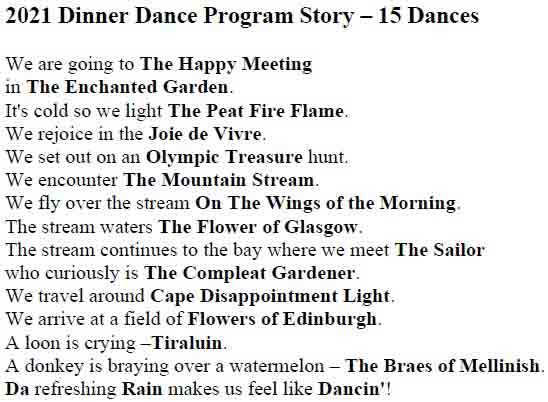
| Volume 37 #1 | July/August 2020 | |
 |
I am curious to explore methods for learning Scottish dancing skills. I have been studying a book and seminars titled Limitless - Upgrade your brain, learn anything faster, and unlock your exceptional life by Jim Kwik. I recorded notes.
The book teaches Metalearning = the science of learning how to learn.
Metalearning Integration = Mindset + Motivation + Method
Mindset = What ; Motivation = Why ; Method = How
The content is oriented toward learning through reading, but we can extend to learning dancing skills. The author is a memory expert, so I explored his Memory method to see how it relates to learning Scottish dancing skills.
Here are some concepts from the book:
There is no such thing as a good memory or bad memory – only a trained versus untrained memory.
A memory is not something you have – it's something you do.
Memory = Information + Emotion
The basic principle for learning is: M.O.M.
M is for Motivation – you are more likely to remember something. Ask: Why do I want to remember?
O is for Observation – pay attention for improved retention. Listen, be present in any situation.
M is for Methods – your mental toolkit. Methods like Memory are a process.
Learning is as easy as P.I.E. – Place, Imagine, Entwine.
Location – In order to remember something, you need to associate it with a place when you visualize it. We are wired to remember where things are, for our survival.
Visualization – You can remember something better when you can imagine it – see and feel and hear it. A lot of people remember what they see more than what they hear – for example, they remember a face but forget a name.
Association – Connect the Place + Image – for example, imagine ten things and entwine them together with a story.
 |
I tested the method by creating a story to remember next year's 2021 Dinner Dance program of 15 dance names in order. We can view the cribs and diagrams and animations.
I generated an imaginary story to entwine place with dance names. I am easily able to recall the story and name all fifteen dances in order. Even better is that others can also use the same story to imagine and memorize each of the places with their own picture of the story, more easily compared with my picture. (I have a note to verify how well I can recall the story near the Dinner Dance date in May 2021.)
Dancers are typically challenged to remember the choreography of dances in a dance program. The cribs and diagrams and animations are circulated to dancers for study prior to coming to a dance event. There is typically a recap and/or walk thru just before the dancing begins as a memory aid. I have observed for my brain that viewing the animations while listening to narrated formations helps me imagine the places I will travel in a dance set, more effectively than reading the cribs. I count the 8-bar dance formations to help remember them while listening by physically extending my fingers: one, two, three, four. In the case of the 2021 Dinner Dance program, I already have strong memories for five of the dances because I have danced them before and made emotional memories. I have felt the movements and I can visualize paths, steps, phrasing and covering. I have weaker memories for the other dances so far. Practicing the dances during classes forms emotional memories. Listening to the music while visualizing or moving along the path strengthens memory.
I reviewed Chapter 1 Learning to Dance from A Handbook for Scottish Country Dance Teachers – Fourth Edition by Geoffrey and Cecily Selling about how the brain learns dancing skills and why teaching methods are effective. The content is compatible with the Limitless model. The teacher audience is advised how people learn, through modalities: seeing, hearing, moving and touching, and that dancing must be learned by moving. The teacher needs to take into account the variety of dancer-preferred modalities. Dancers can additionally explore the Limitless metalearning model in order to train their memory for learning dancing skills.